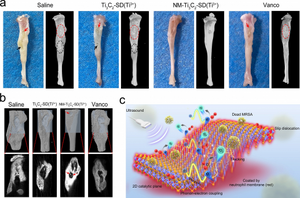A research team at the University of Hong Kong has developed a novel two-dimensional (2D) sonosensitiser to tackle bone tissue infection. The team’s innovative solution, Ti3C2-SD(Ti3+) nano-sheets, can effectively generate a substantial amount of bactericide (ROS) when triggered by ultrasound signals. After decorated with neutrophil membrane (NM), the nano-sheets can capture MRSA bacteria deeply seated in bony tissue, effectively eliminating them with a success rate of 99.72%. The technology also has the potential to alleviate tissue inflammation and assist in bone repair once bony tissue infection is controlled.
The research offers a promising alternative solution to traditional treatments for bone tissue infection that often rely on antibiotics and surgical debridement. Osteomyelitis, a bone infection caused by bacteria, fungi, or other microorganisms, can put patients at risk of amputation or life-threatening sepsis if left untreated. The team’s work could offer a solution to post-operation bacterial infection commonly seen in bone cancer patients, cystitis, and peritonitis in the future. The research was supported by several programmes, including the National Key R&D Programmes of China and the Hong Kong Health and Medical Research Fund.
A team of researchers led by Professor Kelvin Yeung Wai-kwok from the Department of Orthopaedics and Traumatology, School of Clinical Medicine, LKS Faculty of Medicine, the University of Hong Kong (HKUMed), has developed a groundbreaking solution to tackle bone tissue infection.
The team has created two-dimensional (2D) ultrasound-responsive antibacterial nano-sheets that can effectively combat methicillin-resistant Staphylococcus aureus (MRSA) infection in bony tissue. Unlike traditional treatments that often rely on antibiotics and surgical debridement, this non-invasive technology offers an antibiotic-free solution to reduce bone infections and its related complications.
The novel antibacterial nano-sheets can release a significant amount of reactive oxygen species (ROS) when subjected to ultrasound stimulation. By engulfing neutrophil membrane (NM), the nano-sheets can capture MRSA bacteria deeply seated in bony tissue, effectively eliminating them with a success rate of 99.72% ± 0.03%. The outcome of this research has been published in Advanced Materials.
Osteomyelitis is a bone infection caused by bacteria, fungi, or other microorganisms, with MRSA being the most common causative pathogenic organism. If left untreated, this condition can put patients at risk of amputation or even induce life-threatening sepsis. In the past, bone tissue infection treatments typically involved antibiotics and surgical debridement to remove infected tissue. However, excessive use of antibiotics can compromise the host’s immune function and lead to the emergence of drug-resistant pathogens.
The team’s research offers a promising alternative solution to traditional treatments. Phototherapy, whether it is photodynamic or photothermal therapy, has recently been applied as an antibiotic-free strategy to combat bacterial infections. However, conventional phototherapy has limited penetration power and cannot tackle deep tissue infections such as those found in bones. Therefore, an alternative antibiotic-free strategy harnessing the penetration power of ultrasound to human tissues is considered an exciting breakthrough.
A research team from the University of Hong Kong (HKUMed) has invented a new two-dimensional (2D) sonosensitiser, Ti3C2-SD(Ti3+) nano-sheets, that can effectively combat bone tissue infection. Compared with conventional zero-dimensional sonosensitisers, the 2D sonosensitiser is more efficient in generating reactive oxygen species (ROS) that can eliminate bacteria.
The novel antibacterial nano-sheets, decorated with neutrophil membrane (NM), can actively track down MRSA bacteria in bony tissue when subjected to ultrasound stimulation. In animal models, the nano-sheets eliminated MRSA bacteria in bone by more than 99.72%, while antibiotic therapy was ineffective. Additionally, the NM-coated nano-sheets do not pose any acute bio-safety risks and can also alleviate tissue inflammation and assist in bone repair after controlling the bony tissue infection.
Professor Kelvin Yeung Wai-kwok, who led the study, said, “Our design has achieved a qualitative leap in which the ROS catalytic site in sonosensitiser has transformed from zero-dimensional to two-dimensional. This invention can remarkably increase the production of bactericide (ROS). We may also consider applying this invention to the post-operation bacterial infection commonly seen in bone cancer patients or the patients with cystitis and peritonitis in the future.”
Professor Yeung’s research interests include orthopaedic biomaterials, spinal deformities, musculoskeletal tissue engineering, anti-bacterial nano-materials, and 3D bio-printing. The research study was conducted by Dr Mao Congyang, postdoctoral fellow, and Professor Yeung’s team from the Department of Orthopaedics and Traumatology, School of Clinical Medicine, HKUMed.
The research team’s work was supported by several programmes, including the National Key R&D Programmes of China, the Hong Kong Health and Medical Research Fund, the General Research Fund of Hong Kong Research Grant Council, and the Shenzhen Science and Technology Funding.
In conclusion, the team’s invention offers a promising alternative to traditional treatments for bone tissue infection that often rely on antibiotics and surgical debridement. The new technology can assist in controlling the MRSA bacteria in bony tissue and potentially alleviate tissue inflammation while also aiding in bone repair.
Don’t miss interesting posts on Famousbio

